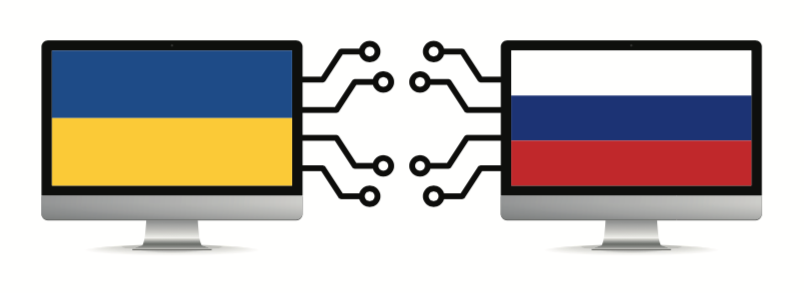Report: Recent 10x Increase in Cyberattacks on Ukraine
Credit to Author: BrianKrebs| Date: Fri, 11 Mar 2022 16:50:11 +0000
As their cities suffered more intense bombardment by Russian military forces this week, Ukrainian Internet users came under renewed cyberattacks, with one Internet company providing service there saying they blocked ten times the normal number of phishing and malware attacks targeting Ukrainians.

John Todd is general manager of Quad9, a free “anycast” DNS platform. DNS stands for Domain Name System, which is like a globally distributed phone book for the Internet that maps human-friendly website names (example.com) to numeric Internet addresses (8.8.4.4.) that are easier for computers to manage. Your computer or mobile device generates DNS lookups each time you send or receive an email, or browse to a webpage.
With anycast, one Internet address can apply to many servers, meaning that any one of a number of DNS servers can respond to DNS queries, and usually the one that is geographically closest to the customer making the request will provide the response.
Quad9 insulates its users from a range of cyberattacks by blocking DNS requests for known-bad domain names, i.e., those confirmed to be hosting malicious software, phishing websites, stalkerware and other threats. And normally, the ratio of DNS queries coming from Ukraine that are allowed versus blocked by Quad9 is fairly constant.
But Todd says that on March 9, Quad9’s systems blocked 10 times the normal number of DNS requests coming from Ukraine, and to a lesser extent Poland.
Todd said Quad9 saw a significant drop in traffic reaching its Kyiv POP [point of presence] during the hostilities, presumably due to fiber cuts or power outages. Some of that traffic then shifted to Warsaw, which for much of Ukraine’s networking is the next closest significant interconnect site.
“While our overall traffic dropped in Kyiv — and slightly increased in Warsaw due to infrastructure outages inside of .ua — the ratio of (good queries):(blocked queries) has spiked in both cities,” he continued. “The spike in that blocking ratio [Wednesday] afternoon in Kyiv was around 10x the normal level when comparing against other cities in Europe (Amsterdam, Frankfurt.) While Ukraine always is slightly higher (20%-ish) than Western Europe, this order-of-magnitude jump is unprecedented.”
Quad9 declined to further quantify the data that informed the Y axis in the chart above, but said there are some numbers the company is prepared to share as absolutes.
“Looking three weeks ago on the same day of the week as yesterday, we had 118 million total block events, and of that 1.4 million were in Ukraine and Poland,” Todd said. “Our entire network saw yesterday on March 9th 121 million blocking events, worldwide. Of those 121 million events, 4.6 million were in Ukraine and Poland.”
Bill Woodcock is executive director at Packet Clearing House, a nonprofit based in San Francisco that is one of several sponsors of Quad9. Woodcock said the spike in blocked DNS queries coming out of Ukraine clearly shows an increase in phishing and malware attacks against Ukrainians.
“They’re being targeted by a huge amount of phishing, and a lot of malware that is getting onto machines is trying to contact malicious command-and-control infrastructure,” Woodcock said.
Both Todd and Woodcock said the smaller spike in blocked DNS requests originating from Poland is likely the result of so many Ukrainians fleeing their country: Of the two million people who have fled Ukraine since the beginning of the Russian invasion, more than 1.4 million have made their way to Poland, according to the latest figures from the United Nations.
The increase in malicious activity detected by Quad9 is the latest chapter in an ongoing series of cyberattacks against Ukrainian government and civilian systems since the outset of the war in the last week of February.
As Russian military tanks and personnel began crossing the border into Ukraine last month, security experts tracked a series of destructive data “wiper” attacks aimed at Ukrainian government agencies and contractor networks. Security firms also attributed to Russia’s intelligence services a volley of distributed denial-of-service (DDoS) attacks against Ukrainian banks just prior to the invasion.
Thus far, the much-feared large scale cyberattacks and retaliation from Russia haven’t materialized (for a counterpoint here, see this piece from The Guardian). But the data collected by Quad9 suggest that a great deal of low-level cyberattacks targeting Ukrainians remain ongoing.
It is unclear to what extent — if any — Russia’s vaunted cyber prowess may be stymied by mounting economic sanctions enacted by both private companies and governments. In the past week, two major backbone Internet providers said they would stop routing traffic for Russia.
Earlier today, the London Internet Exchange (LINX), one of the largest peering points where networks around the world exchange traffic, said it would stop routing for Russian Internet service providers Rostelecom and MegaFon. Rostelecom is Russia’s largest ISP, while MegaFon is Russia’s second-largest mobile phone operator and third largest ISP.
Doug Madory, director of research for Internet infrastructure monitoring firm Kentik, said LINX’s actions will further erode the connectivity of these large Russia providers to the larger Internet.
“If the other major European exchanges followed suit, it could be really problematic for Russian connectivity,” Madory said.
